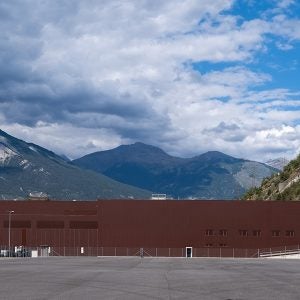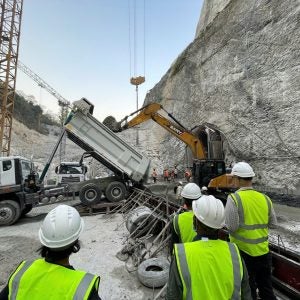Standing at 285m high, Switzerland’s Grande Dixence dam boasts the title of being the world’s highest gravity dam. This engineering feat is also described as the jewel in the crown of the Grande Dixence complex which harnesses the vast hydro potential of a unique glacial basin covering 350km2. The run off from 35 glaciers in the Valasian Alps is impounded in a 400Mm3 reservoir area. This water then powers Fionnay and Nendaz hydro plants, plus the older Chandoline station. The three plants have a total installed generating capacity of 800MW and take 2200 hr to turbine the water that Grande Dixence can hold. This huge energy resource represents 20% of Switzerland’s stored energy.
The origins of the Grande Dixence scheme can be traced back to the post World War ll era. Switzerland needed to develop its industries and in 1945 the Swiss Federal Water Department took a closer look at the country’s hydro power potential.
The Dix valley was chosen as the preferred site with the greatest potential for development. In 1951 construction work started at Grande Dixence to collect water from the Viège river in the Matter Valley and the Borgne river in the Hérens Valley. The first Dixence dam, which had been built only 15 years previously, was to be submerged in the new reservoir (see shaded panel on Chandoline power plant).
Construction continued on a mass scale never witnessed in the country before. Over 3000 labourers worked on the scheme at 23 high altitude sites, and it was finally completed three years ahead of schedule in 1961. Part of this success was attributed to the uninterrupted supply of local construction materials which enabled the pace of construction to be maintained night and day. The raw material for the dam was quarried from the Prafleuri moraine at an altitude of above 2600m. The rock was crushed on the spot and then transported by conveyor belts to the Blava concrete plant. The cement was put in 400kg canisters before being transported back to the site at a pace of 200 tonnes an hour.
An inspiring feature of the Grande Dixence scheme is its ability to collect water from 35 glaciers from the Zermatt to the Hérens valley in the Valais region. The need for four pumping stations was necessary as certain major glaciers in the scheme, such as Ferpècle, Arolla, Z’Mutt and Stafel, are at a lower level than the main water conduit which is at 2400m. Full commissioning of the complex project took place in 1965.
The Grande Dixence scheme comprises:
• A 285m high concrete gravity dam with a crest of 700m and 400Mm3 of reservoir capacity.
• Two power plants (Fionnay 290MW and Nendaz 390MW).
• 100km of tunnels. Plus a main collection conduit at an altitude of 2400m which flows into Lac des Dix.
• 75 intakes.
• Four pumping stations (Z’Mutt, Stafel, Ferpècle and Arolla).
• Two balancing reservoirs: Z’Mutt has a reservoir capacity of 840,000m3. Impounded by a 74m high arch dam with a 144m crest. Ferpècle has a reservoir capacity of 100,000m3. It is impounded by a 26m high arch dam with a 91m crest. Both were built in 1962 and commissioned in 1964.
The Cleuson-Dixence hydro scheme was built between 1993 and 1998 to increase the production capacity of Grande Dixence. Its aim was to complement the existing scheme and add an extra 1200MW of generating capacity so as to make optimum use of the hydro power potential. With Cleuson-Dixence the time taken to turbine the 400Mm3 impounded by Grande Dixence is reduced from 2200hr to 1000hr; increasing the power generating capacity of the combined complex by a factor of 2.5 to 2000MW. Annual energy production rates at 2BkWh.
Cleuson-Dixence was constructed entirely underground. It comprises:
• A new water intake in the Grande Dixence dam.
• 15.8km of collecting works.
• A surge tank dug out of the Dent-de-Nendaz mountains.
• A 4.3km steel-lined shaft.
• The 1200MW Bieudron underground powerhouse.
However, only two years after commissioning in December 2000 an incident at Cleuson-Dixence put the plant out of action for over nine years. Defective welds in the underground penstock from Grande Dixence dam to Bieudron power plant led to a dramatic burst. At an elevation of 1234m, a 9m long and 60cm wide section of the penstock was torn open.
Although emergency action rapidly followed, a large outflow of water could not be prevented from reaching the Nendaz and Fey areas.
The rehabilitation works began in 2005. Following a series of geological measurements and technical studies, interior lining for the ruptured penstock was considered to be the best solution. The unsafe rock structure in the accident zone had to be circumvented by a bypass. The damaged portion of the shaft was filled over a length of 117m and two additional galleries were dug on both ends to allow for building the bypass.
The Bieudron plant has been fully operational since 25 January 2010. The total cost of the rehabilitation work has been estimated at CHF365M (US$360M).
| Chandoline power plant and Dixence dam |
Construction of the Chandoline power plant and the first Dixence dam was carried out from 1929-34. With a reservoir capacity of 50Mm3, they were built to utilise the hydro power potential of the Val des Dix drainage basin. Commissioning of the 87m high Cleuson dam in 1951, with a capacity of 20Mm3, also enabled Chandoline to tap into the upper Val de Nendaz catchment area. Until 1957 its 1748m head was considered to be the highest in the world. |
| The Swiss Committee on Dams highlights the importance of the Grande Dixence complex |
The first concrete dam of Europe was built in Fribourg, Switzerland in 1872. It was a simple, 24m high structure. Little by little, the height and volume of Swiss dams increased. As time passed by, experience was gained and formal knowledge of the statics and behaviour of these structures developed; and larger and bolder dams were conceived. The vast majority were made of concrete. |
Tables
Pumping station data
Power station data






